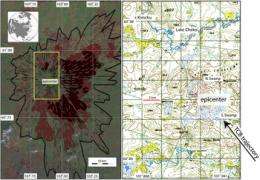May 21, 2012 report
Research team claims to have found evidence Lake Cheko is impact crater for Tunguska Event

(Phys.org) -- Early on the morning of June 30th, 1908, a huge explosion occurred in a remote part of Siberia near the Podkamennaya Tunguska River. So great was the blast that trees were knocked down in neat rows for nearly a thousand square miles and the sky lit up from parts of Asia to Great Britain. What caused that explosion has never been firmly settled. Most researchers agree that it was the result of either a comet or meteoroid, with most leaning towards the former due to the lack of both an impact crater and meteoroid fragments. Now however, a research team from Italy says that they have found proof that it was in fact a meteorite that struck the Earth and that a nearby lake is the impact crater. They have published the results of their findings in Geochemistry, Geophysics, Geosystems.
For years, amateurs and professionals alike have debated the cause of the Tunguska Event, as it’s come to be known as. Some suggest it was the work of extraterrestrials while others say it was god’s way of getting our attention. Serious scientists, on the other hand, have suggested its most likely cause was a comet melting and then vaporizing as it hit, leaving no real evidence behind. Unfortunately, that theory doesn’t hold up very well in light of the fact that scientists have found differences in the levels of carbon, nitrogen and isotopes of hydrogen and iridium, from the surrounding area which are similar in some respects to those found with certain asteroids. Also, tiny particles that sort of resemble meteorite components have been found in the wood of the fallen trees. None of this evidence can rule anything out however as it could mean there was a comet that had some rocks in it or a meteorite that vaporized due to a soft composition.
The Italian teams says it was a meteorite and claim they have proof of their assertion in the form of an as yet uncovered piece of something tangible beneath the sediment at the bottom of Lake Cheko; a shallow funnel shaped lake approximately five miles from where most believe was ground zero for the explosion.
The team came to this conclusion after performing seismic measurements on the lake bottom in 1999 which showed that sentiment had been building for just about a hundred years, which would of course put it close to the Tunguska Event and also gave evidence of something dense near the middle of the lake.
Further evidence came to light they say in 2009 when they returned to the lake and performed a magnetic survey, which they say showed an anomaly in the same location as their seismic measurements had detected. Now, after three more years of studying evidence they collected from the site, they’ve concluded that Lake Cheko is indeed an impact crater and that the dense object beneath the lakebed is the smoking gun.
Others of course aren’t so sure, and likely will remain pessimistic until someone digs up the object and studies it, proving it to be nothing more than a regular rock, or an object from space that left an impact crater as it struck over a century ago, finally solving the mystery.
More information: Magnetic and seismic reflection study of Lake Cheko, a possible impact crater for the 1908 Tunguska Event, Geochemistry, Geophysics, Geosystems, VOL. 13, Q05008, 12 PP., 2012. doi:10.1029/2012GC004054
Abstract
A major explosion occurred on 30 June 1908 in the Tunguska region of Siberia, causing the destruction of over 2,000 km2 of taiga; pressure and seismic waves detected as far as 1,000 km away; bright luminescence in the night skies of Northern Europe and Central Asia; and other unusual phenomena. This “Tunguska Event” is probably related to the impact with the Earth of a cosmic body that exploded about 5–10 km above ground, releasing in the atmosphere 10–15 Mton of energy. Fragments of the impacting body have never been found, and its nature (comet or asteroid) is still a matter of debate. We report here results from a magnetic and seismic reflection study of a small (∼500 m diameter) lake, Lake Cheko, located about 8 km NW of the inferred explosion epicenter, that was proposed to be an impact crater left by a fragment of the Tunguska Cosmic Body. Seismic reflection and magnetic data revealed a P wave velocity/magnetic anomaly close to the lake center, about 10 m below the lake floor; this anomaly is compatible with the presence of a buried stony object and supports the impact crater origin for Lake Cheko.
© 2012 Phys.Org


















